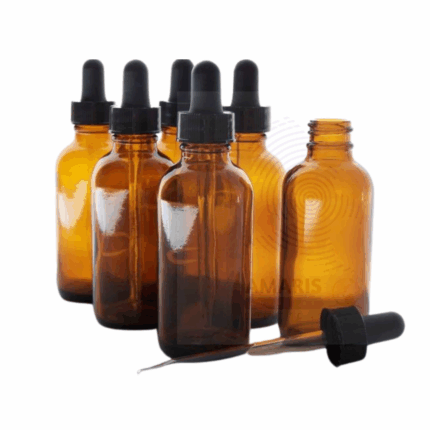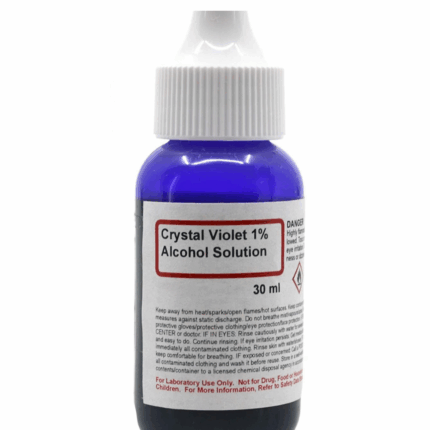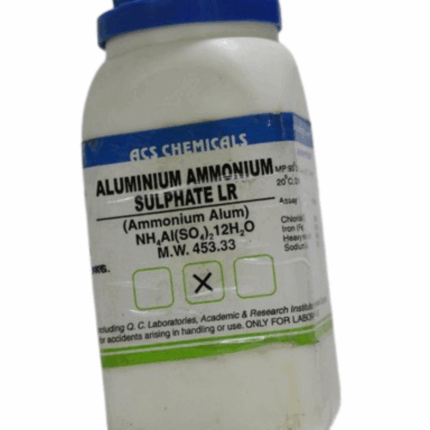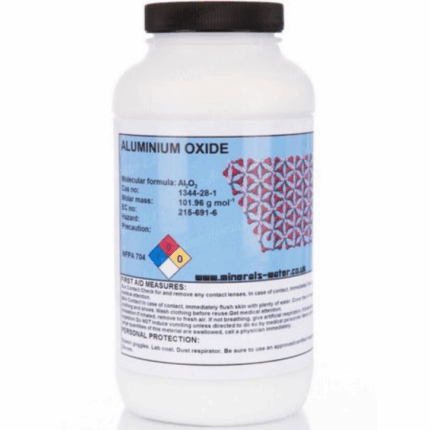Glycerol Monostearate (GMS) Extra Pure
SHORT DESCRIPTION
Glycerol Monostearate (GMS) Extra Pure is a high-purity, white, odorless, and tasteless powder or flake widely used as an emulsifier, thickening agent, and stabilizer. In laboratory and industrial settings, it is particularly valuable for its role in forming stable emulsions in aqueous and oily systems. Commonly used in food science experiments, pharmaceutical formulations, and cosmetic product development, GMS improves consistency and shelf-life. It also serves as a dispersing agent and plasticizer in various polymer applications. Its extra pure grade ensures reliable performance where precision and chemical cleanliness are required.
USES
Primary Laboratory Uses:
- Emulsifier in formulation research:
Commonly used in laboratory studies to stabilize oil-in-water emulsions, particularly in food science, cosmetic, and pharmaceutical research. - Controlled-release matrix in drug formulation studies:
Serves as a lipid-based excipient in sustained or delayed drug delivery systems for experimental pharmaceutical applications.
Secondary Laboratory Uses:
- Surfactant in dispersion and coating trials:
Acts as a wetting agent or dispersant in various chemical and biological coatings, helping distribute active compounds evenly. - Texture modifier in food simulation experiments:
Utilized in model food systems to mimic texture and mouthfeel, especially in studies involving fats and fat replacers. - Carrier in encapsulation studies:
Used to develop microencapsulation techniques for active ingredients like vitamins or enzymes.
KEY ATTRIBUTES
1. Basic Identification Attributes
- Chemical Name: Glycerol Monostearate
- Other Names: GMS, Glyceryl Monostearate, Monostearin
- Chemical Formula: C₂₁H₄₂O₄
- CAS Number: 31566-31-1 (or 123-94-4 for general GMS)
- Molecular Weight: ~358.56 g/mol
- Grade: Extra Pure (Laboratory/Reagent Grade)
- Appearance: White to off-white flaky powder or waxy solid
- Odor: Mild or odorless
2. Physical & Chemical Properties
- Melting Point: 55–65 °C
- Solubility:
- Insoluble in water
- Soluble in ethanol, acetone, and hot oils/fats
- Density: ~1.03 g/cm³
- Hydrophilic-Lipophilic Balance (HLB): ~3.8 (acts as a low-HLB emulsifier)
3. Safety & Hazard Attributes
- Hazard Classification (GHS):
✅ Not classified as hazardous under normal lab use - Hazard Statements:
- May cause mild skin or eye irritation on prolonged contact
- PPE Requirements:
- Lab coat
- Gloves (nitrile or latex)
- Safety goggles
- First Aid Measures:
- Inhalation: Move to fresh air if irritation occurs
- Skin Contact: Wash with soap and water
- Eye Contact: Rinse with water for several minutes
- Ingestion: Non-toxic in small amounts; seek medical advice if large quantity ingested
4. Storage & Handling Attributes
- Storage Conditions:
- Keep container tightly closed
- Store in a cool, dry place, away from direct heat and moisture
- Avoid contamination with oxidizing agents
- Handling Notes:
- Avoid dust formation during transfer
- Clean spills to prevent slipping hazards
5. Regulatory & Compliance Attributes
- Food/Pharma Relevance:
- GRAS status (Generally Recognized As Safe) in food/pharma at specific grades
- Commonly used as an emulsifier, thickener, or anti-caking agent
- Labeling Compliance:
- Label as per GHS even if non-hazardous for lab tracking
- Include batch and expiry details for accurate lab use
6. Laboratory Applications
- Primary Uses:
- Used as an emulsifying agent in chemical formulations
- Carrier or stabilizer in enzyme/protein-based systems
- Coating agent or excipient in lab-scale pharmaceutical formulations
- Secondary Uses:
- Controlled-release agent in drug delivery research
- Stabilizer in cosmetic and personal care product testing
- Reference standard for lipid and fat analysis
SAFETY PRECAUTIONS
Personal Protective Equipment (PPE):
- Wear a lab coat, nitrile gloves, and protective goggles.
- Use a dust mask or operate in a well-ventilated area to prevent inhalation of fine particles.
Handling:
- Avoid contact with skin and eyes.
- Minimize dust generation and accumulation.
- Wash hands thoroughly after handling.
Storage:
- Store in a cool, dry, well-ventilated area.
- Keep the container tightly sealed.
- Protect from moisture and incompatible materials such as strong oxidizers.
FIRST AID MEASURES
Inhalation:
- Move the affected person to fresh air.
- Seek medical advice if respiratory discomfort or irritation occurs.
Skin Contact:
- Wash with soap and plenty of water.
- Remove contaminated clothing.
- Seek medical attention if irritation develops.
Eye Contact:
- Rinse cautiously with clean water for several minutes.
- Remove contact lenses if present and easy to do.
- Seek medical attention if irritation persists.
Ingestion:
- Rinse mouth with water.
- Do not induce vomiting.
- Seek medical advice if symptoms occur or large amounts are ingested.
FIRE FIGHTING MEASURES
Flammability:
- Combustible under fire conditions; may form combustible dust-air mixtures.
Extinguishing Media:
- Use dry chemical, foam, carbon dioxide (CO₂), or water spray.
- Avoid high-pressure water jets that may spread burning material.
Hazardous Combustion Products:
- May emit carbon monoxide, carbon dioxide, and acrolein when decomposed by heat.
Firefighter Protection:
- Wear full protective gear and self-contained breathing apparatus (SCBA).
- Avoid inhalation of combustion fumes.


 Acidulants
Acidulants Antioxidants
Antioxidants Nutraceutical Ingredients (food)
Nutraceutical Ingredients (food)
 Collectors
Collectors Dust Suppressants
Dust Suppressants Explosives and Blasting Agents
Explosives and Blasting Agents Flocculants and Coagulants
Flocculants and Coagulants Frothers
Frothers Leaching Agents
Leaching Agents pH Modifiers
pH Modifiers Precious Metal Extraction Agents
Precious Metal Extraction Agents
 Antioxidants(plastic)
Antioxidants(plastic) Colorants (Pigments, Dyes)
Colorants (Pigments, Dyes) Fillers and Reinforcements
Fillers and Reinforcements Flame Retardants
Flame Retardants Monomers
Monomers Plasticizers
Plasticizers Polymerization Initiators
Polymerization Initiators Stabilizers (UV, Heat)
Stabilizers (UV, Heat)
 Antifoaming Agents
Antifoaming Agents Chelating Agents
Chelating Agents Coagulants and Flocculants
Coagulants and Flocculants Corrosion Inhibitors
Corrosion Inhibitors Disinfectants and Biocides
Disinfectants and Biocides Oxidizing Agents
Oxidizing Agents pH Adjusters
pH Adjusters Scale Inhibitors( water)
Scale Inhibitors( water)
 Antioxidants(cosmetic)
Antioxidants(cosmetic) Emollients
Emollients Fragrances and Essential Oils
Fragrances and Essential Oils Humectants
Humectants Preservatives
Preservatives Surfactants(cosmetic)
Surfactants(cosmetic) Thickeners
Thickeners UV Filters
UV Filters
 Fertilizers
Fertilizers Soil Conditioners
Soil Conditioners Plant Growth Regulators
Plant Growth Regulators Animal Feed Additives
Animal Feed Additives Biostimulants
Biostimulants Pesticides (Herbicides, Insecticides, Fungicides)
Pesticides (Herbicides, Insecticides, Fungicides)
 Active Pharmaceutical Ingredients (APIs)
Active Pharmaceutical Ingredients (APIs) Excipients
Excipients Solvents(pharmaceutical)
Solvents(pharmaceutical) Antibiotics
Antibiotics Antiseptics and Disinfectants
Antiseptics and Disinfectants Vaccine Adjuvants
Vaccine Adjuvants Nutraceutical Ingredients (pharmaceutical)
Nutraceutical Ingredients (pharmaceutical) Analgesics & Antipyretics
Analgesics & Antipyretics
 Analytical Reagents
Analytical Reagents Chromatography Chemicals
Chromatography Chemicals Spectroscopy Reagents
Spectroscopy Reagents Molecular Biology Reagents
Molecular Biology Reagents Biochemical Reagents
Biochemical Reagents Inorganic and Organic Standards
Inorganic and Organic Standards Laboratory Safety Chemicals
Laboratory Safety Chemicals Specialty Laboratory Chemicals(Special Laboratory Equipment)
Specialty Laboratory Chemicals(Special Laboratory Equipment)
 Demulsifiers
Demulsifiers Hydraulic Fracturing Fluids
Hydraulic Fracturing Fluids Scale Inhibitors(oil)
Scale Inhibitors(oil) Surfactants(oil)
Surfactants(oil) Drilling Fluids
Drilling Fluids
 Dyes and Pigments
Dyes and Pigments Bleaching Agents
Bleaching Agents Softening Agents
Softening Agents Finishing Agents
Finishing Agents Antistatic Agents
Antistatic Agents
 Admixtures
Admixtures Waterproofing Agents
Waterproofing Agents Sealants and Adhesives
Sealants and Adhesives Curing Compounds
Curing Compounds Concrete Repair Chemicals
Concrete Repair Chemicals Anti-Corrosion Coatings
Anti-Corrosion Coatings
 Surfactants(cleaning)
Surfactants(cleaning) Builders
Builders Enzymes
Enzymes Solvents (Cleaning)
Solvents (Cleaning) Fragrances
Fragrances
 Electronic Chemicals
Electronic Chemicals Catalysts
Catalysts Lubricants
Lubricants Photographic Chemicals
Photographic Chemicals Refrigerants
Refrigerants Automotive chemicals
Automotive chemicals Pyrotechnic Chemicals
Pyrotechnic Chemicals
 Biodegradable Surfactants
Biodegradable Surfactants Bio-based Solvents
Bio-based Solvents Renewable Polymers
Renewable Polymers Carbon Capture Chemicals
Carbon Capture Chemicals Wastewater Treatment Chemicals
Wastewater Treatment Chemicals
 Pigments
Pigments Solvents(paint)
Solvents(paint) Specialty Coatings
Specialty Coatings Binders/Resins
Binders/Resins Additives
Additives Driers
Driers Anti-Corrosion Agents
Anti-Corrosion Agents Functional Coatings
Functional Coatings Application-Specific Coatings
Application-Specific Coatings
 Fresh Herbs
Fresh Herbs Ground Spices
Ground Spices Whole Spices
Whole Spices Spice Blends
Spice Blends Dried Herbs
Dried Herbs
 Leavening Agents
Leavening Agents Dough Conditioners
Dough Conditioners Flour Treatments
Flour Treatments Fat Replacers
Fat Replacers Decoratives
Decoratives Preservatives(baking)
Preservatives(baking)
 Plasticizers & Softeners
Plasticizers & Softeners Reinforcing Agents
Reinforcing Agents Adhesion Promoters
Adhesion Promoters Vulcanizing Agents
Vulcanizing Agents Antidegradants
Antidegradants Blowing Agents
Blowing Agents Fillers & Extenders
Fillers & Extenders Accelerators & Retarders
Accelerators & Retarders





















